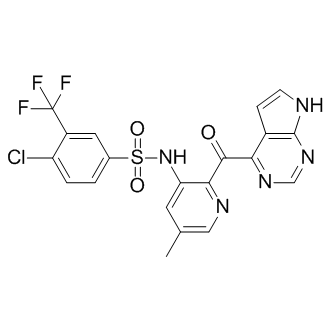
CCX140
CAS No. 1100318-47-5
CCX140( CCX-140 | CCX 140 | CCX140-B | CCX140B )
Catalog No. M10382 CAS No. 1100318-47-5
A potent, selective, orally bioavailable CCR2 antagonist with Kd of 2.3 nM for hCCR2.
Purity : >98% (HPLC)
 COA
COA
 Datasheet
Datasheet
 HNMR
HNMR
 HPLC
HPLC
 MSDS
MSDS
 Handing Instructions
Handing Instructions
| Size | Price / USD | Stock | Quantity |
| 2MG | 45 | In Stock |


|
| 5MG | 56 | In Stock |


|
| 10MG | 83 | In Stock |


|
| 25MG | 124 | In Stock |


|
| 50MG | 185 | In Stock |


|
| 100MG | 277 | In Stock |


|
| 200MG | Get Quote | In Stock |


|
| 500MG | Get Quote | In Stock |


|
| 1G | Get Quote | In Stock |


|
Biological Information
-
Product NameCCX140
-
NoteResearch use only, not for human use.
-
Brief DescriptionA potent, selective, orally bioavailable CCR2 antagonist with Kd of 2.3 nM for hCCR2.
-
DescriptionA potent, selective, orally bioavailable CCR2 antagonist with Kd of 2.3 nM for hCCR2; displays little to no activity against 142 various biologically important receptor, no effect on plasma levels of the CCR2 ligand CCL2 or on the numbers of blood monocytes; potently inhibits CCL2-induced chemotaxis of purified human blood monocytes with IC50 of 8 nM, also inhibits CCL2-induced Ca2+ mobilization in monocytes with IC50 of 3 nM; decreases levels of fasting blood glucose and improves insulin sensitivity in mice.Diabetes Phase 2 Clinical.
-
In VitroCCX140 (CCX140-B) potently inhibits CCL2-induced chemotaxis of purified human blood monocytes with IC50 values of 8 nM in buffer and 200 nM in the presence of 100% human serum. CCX140 also inhibits CCL2-induced Ca2+ mobilization in monocytes with an IC50 value of 3 nM. CCX140 inhibits the binding of 125I-CCL2 to monocytes with an IC50 value of 17 nM. CCX140 has a Kd value of 2.3 nM toward hCCR2. CCX140 also inhibits monocyte chemotaxis mediated by the other CCR2 ligands: CCL8/MCP-2, CCL7/MCP-3, and CCL13/MCP-4.
-
In VivoTreatment of hCCR2 KI mice with CCX140 (CCX140-B) causes a dose-dependent reduction in the number of peritoneal leukocytes after thioglycollate challenge: CCX140 strongly blocks leukocyte infiltration at 30 mg/kg, partially blocks leukocyte infiltration at 10 mg/kg, and fails to block leukocyte infiltration at 3 mg/kg. In DIO hCCR2 KI mice, treatment with 100 mg/kg CCX140 blocks the progressive increase in UAER and ACR. CCX140 maintains lower UAER and ACR values during the entire 8-wk dosing regimen. In DIO mice, the CCR2 antagonist completely blocks the recruitment of inflammatory macrophages to visceral adipose tissue. The mice exhibit reduced hyperglycemia and insulinemia, improved insulin sensitivity, increased circulating adiponectin levels, decreased pancreatic islet size and increased islet number. CCX140 also reduces urine output, glucose excretion, hepatic glycogen and triglyceride content and glucose 6-phosphatase levels.
-
SynonymsCCX-140 | CCX 140 | CCX140-B | CCX140B
-
PathwayGPCR/G Protein
-
TargetChemokine Receptor
-
RecptorChemokine Receptor
-
Research AreaMetabolic Disease
-
IndicationDiabetes
Chemical Information
-
CAS Number1100318-47-5
-
Formula Weight495.8621296
-
Molecular FormulaC20H13ClF3N5O3S
-
Purity>98% (HPLC)
-
Solubility10 mM in DMSO
-
SMILESO=S(C1=CC=C(Cl)C(C(F)(F)F)=C1)(NC2=CC(C)=CN=C2C(C3=C4C(NC=C4)=NC=N3)=O)=O
-
Chemical NameBenzenesulfonamide, 4-chloro-N-[5-methyl-2-(7H-pyrrolo[2,3-d]pyrimidin-4-ylcarbonyl)-3-pyridinyl]-3-(trifluoromethyl)-
Shipping & Storage Information
-
Storage(-20℃)
-
ShippingWith Ice Pack
-
Stability≥ 2 years
Reference
1. Sullivan TJ, et al. J Pharmacol Exp Ther. 2012 Jun 5. doi: 10.1124/jpet.111.190918.
2. Sullivan TJ, et al. Metabolism. 2013 Nov;62(11):1623-32.
3. Sullivan T, et al. Am J Physiol Renal Physiol. 2013 Nov 1;305(9):F1288-97.
molnova catalog



related products
-
GSK 214096
A potent, selective CCR5 antagonist and HIV-1 entry inhibitor.
-
INCB-3344
A potent, selective and orally bioavailable CCR2 antagonist with IC50 of 5.1 nM and 9.5 nM for hCCR2 and mCCR2, respectively.
-
MK-0812
A potent CCR2 specific antagonist that blocks MCP-1 mediated response with an IC50 of 3.2 nM.



 Cart
Cart
 sales@molnova.com
sales@molnova.com


